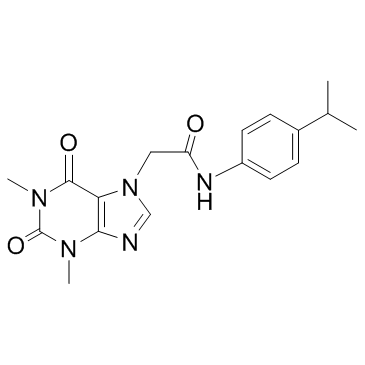349085-38-7
| Name | 2-(1,3-dimethyl-2,6-dioxopurin-7-yl)-N-(4-propan-2-ylphenyl)acetamide |
|---|---|
| Synonyms |
7H-Purine-7-acetamide, 1,2,3,6-tetrahydro-1,3-dimethyl-N-[4-(1-methylethyl)phenyl]-2,6-dioxo-
2-(1,3-Dimethyl-2,6-dioxo-1,2,3,6-tetrahydro-7H-purin-7-yl)-N-(4-isopropylphenyl)acetamide HC-030031 |
| Description | HC-030031 is a potent and selective TRPA1 inhibitor, which antagonizes AITC- and formalin-evoked calcium influx with IC50s of 6.2±0.2 and 5.3±0.2 μM, respectively. |
|---|---|
| Related Catalog | |
| Target |
TRPA1[1] |
| In Vitro | HC-030031 reversibly blocks TRPA1 currents with a similar potency, regardless of the agonist used; this includes blockade of currents elicited by reversible agonists, such as AITC, or irreversible agonists, such as N-methyl maleimide. HC-030031 blocks activation of TRPA1 by N-methyl maleimide, which opens the channel irreversibly through cysteine modification. HC-030031 does not block currents mediated by TRPV1, TRPV3, TRPV4, hERG, or NaV1.2 channels[1]. The potencies of HC-030031 versus cinnamaldehyde or allyl isothiocyanate (AITC or Mustard oil)-induced TRPA1 activation are 4.9±0.1 and 7.5±0.2 μM respectively (IC50). These findings are similar to the previously reported IC50 of 6.2 μM against AITC activation of TRPA1. The ability of HC-030031 to block TRPA1 activation is tested in a FLIPR calcium-influx assay using HEK-293 cells stably expressing human TRPA1. Concentrations of HC-030031 from 0.3 to 60 μM are incubated with cells for 10 minutes prior to addition of an EC60 concentration of either cinnamaldehyde or AITC. HC-030031 dose-dependently blocks cinnamaldehyde- and AITC-induced calcium influx with IC50 values of 4.9 and 7.5 μM, respectively[2]. |
| In Vivo | After injection of AITC (50 μL of 10%) into the rat hind paw, HC-030031 (300 mg/kg) significantly reduces flinching during the first 5 min. Over the remainder of the hour, HC-030031 decreases flinch frequency, a result that mirrors the effects observed on formalin-induced flinching[1]. In the rat, oral administration of HC-030031 reduces AITC-induced nocifensive behaviors at a dose of 100 mg/kg. Moreover, oral HC-030031 (100 mg/kg) significantly reverses mechanical hypersensitivity in the more chronic models of Complete Freunds Adjuvant (CFA)-induced inflammatory pain and the spinal nerve ligation model of neuropathic pain. One hour post-oral administration, HC-030031 significantly reduces the lifting duration following 1% AITC injection (p<0.001)[2]. HC-030031 completely reverses the enhanced mechanical firing in inflamed mice (p<0.001)[3]. |
| Cell Assay | HEK-293 cells stably expressing human TRPA1 are plated into 384-well plates at a density of 20,000 cells/well 24 hours prior to assaying. On the day of assay, cells are loaded with 4 μM Fluo-4 dye and 0.08% pluronic acid for 1 hour at room temperature in assay buffer consisting of Hank's balanced salt solution supplemented with 20 mM HEPES, 2.5 mM probenecid, and 4% TR-40. Calcium influx assays are performed using the Fluorometric Imaging Plate Reader (FLIPR) TETRA. Concentration-response curves are generated for the TRPA1 agonists cinnamaldehyde and AITC prior to antagonist testing so EC60 concentrations could be determined. Titrations of HC-030031 are made from a DMSO stock solution and DMSO is kept to a constant of 0.4% in the assay. The antagonist is incubated with the cells for 10 minutes before the addition of an EC60 concentration of either cinnamaldehyde (18 μM) or AITC (6 μM) and calcium influx is monitored for an additional 10 minutes[2]. |
| Animal Admin | Rats[2] Male Sprague-Dawley rats (200-500 g) are used in all experiments. HC-030031 (100, 300 mg/kg) is used. For all experiments, HC-030031 is suspended in 0.5% Methylcellulose and the drug is dosed p.o. at a volume of 10 mL/kg. Naproxen (20 mg/kg) is dissolved in sterile water and dosed p.o. to serve as a positive comparator for the CFA experiment. Pregabalin (20 mg/kg) is dissolved in sterile water and dosed p.o. to serve as a positive comparator for the neuropathic pain experiment. Mice[3] Adult male C57BL/6 mice (8-12 weeks old) are used. Mice are injected with a 30 µL emulsion of undiluted CFA into the medial left plantar hind paw. The vehicle control group is injected with 30 µL of sterile 0.9% saline solution. Two days after injection, at the peak of hypersensitivity, the magnitude of inflammation is measured at the midpoint of the hind paw using digital calipers (VWR). For one experiment, the membrane-impermeable sodium channel inhibitor lidocaine N-ethyl-bromide, also known as QX-314, (0.2% in saline; 30 µL) is injected with or without the TRPA1 agonist cinnamaldehyde (30 µM) into the left plantar hind paw 2 days post CFA injection. For another experiment, the TRPA1 antagonist HC-030031 (100 µg in 30 µL of 0.5% DMSO and 0.25% Tween-80 in PBS) is injected into the left plantar hind paw 2 days post CFA injection. Vehicle controls are injected with 30 µL 0.5% DMSO and 0.25% Tween-80 in PBS. All behavioral assays are completed between 1 and 4 hours following the QX-314, HC-030031 or vehicle injections. |
| References |
| Density | 1.3±0.1 g/cm3 |
|---|---|
| Molecular Formula | C18H21N5O3 |
| Molecular Weight | 355.391 |
| Exact Mass | 355.164429 |
| PSA | 90.92000 |
| LogP | 2.21 |
| Index of Refraction | 1.652 |
| Symbol |

GHS06 |
|---|---|
| Signal Word | Danger |
| Hazard Statements | H301 |
| Precautionary Statements | P301 + P310 |
| Personal Protective Equipment | Eyeshields;Faceshields;Gloves;type P2 (EN 143) respirator cartridges |
| RIDADR | UN 2811 6.1 / PGIII |
